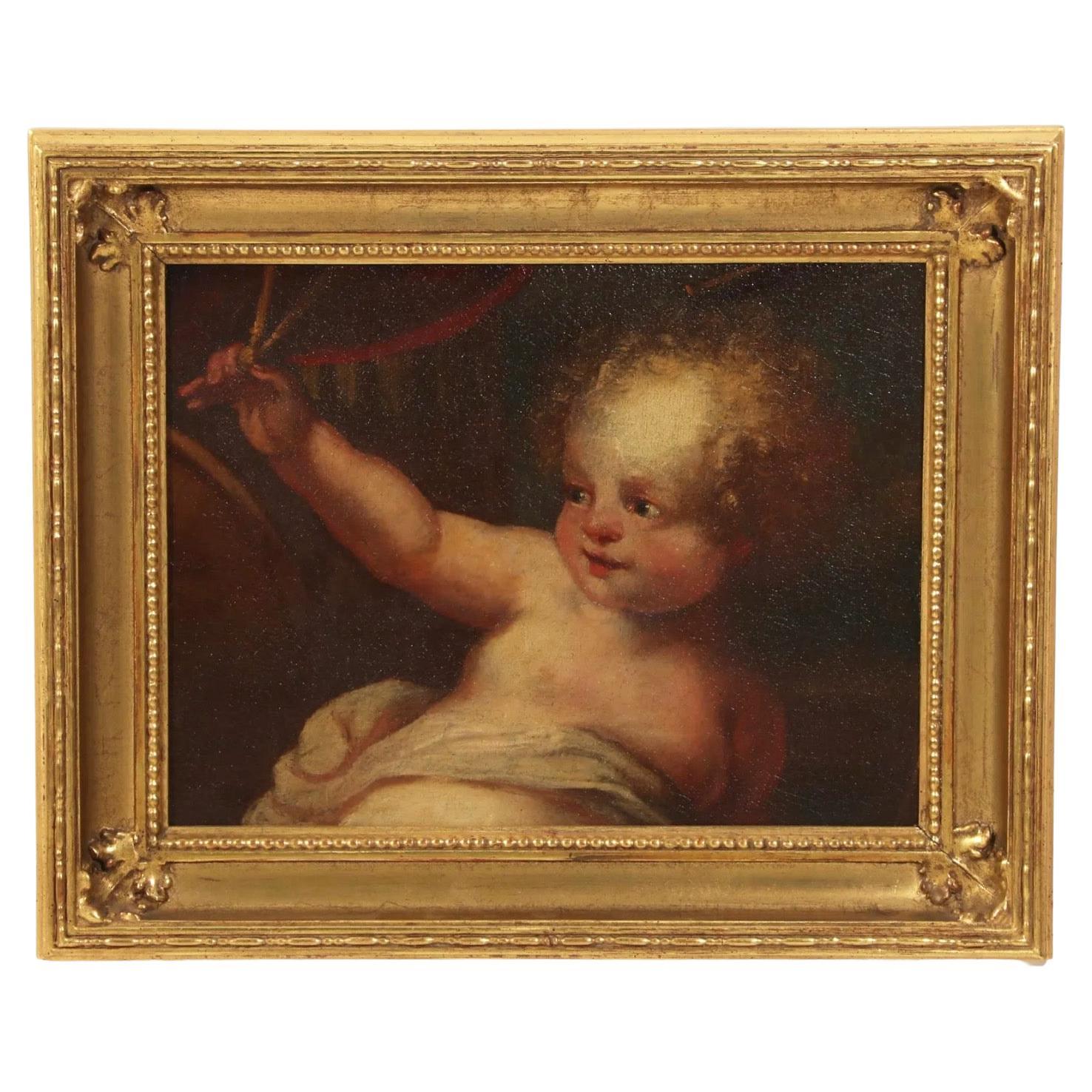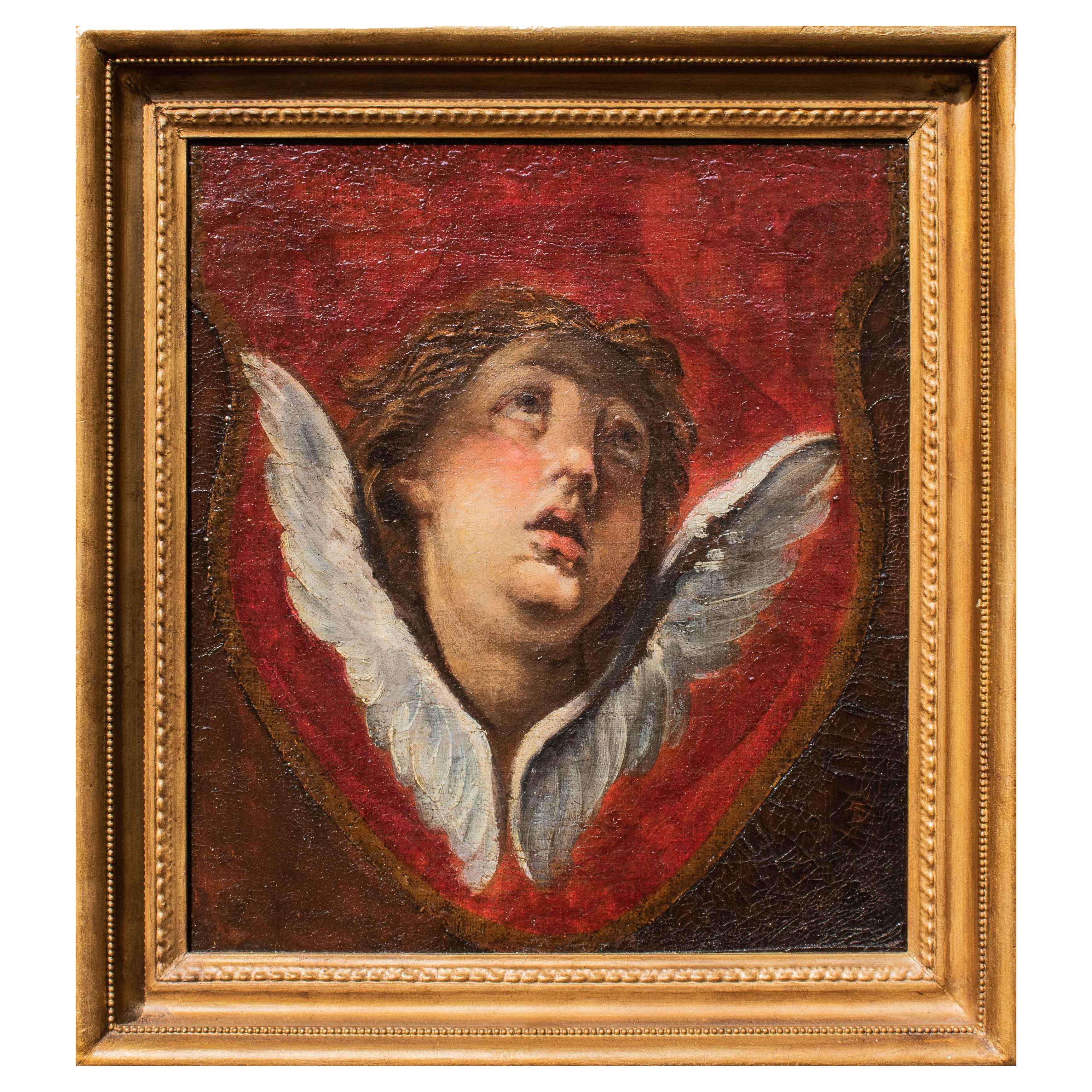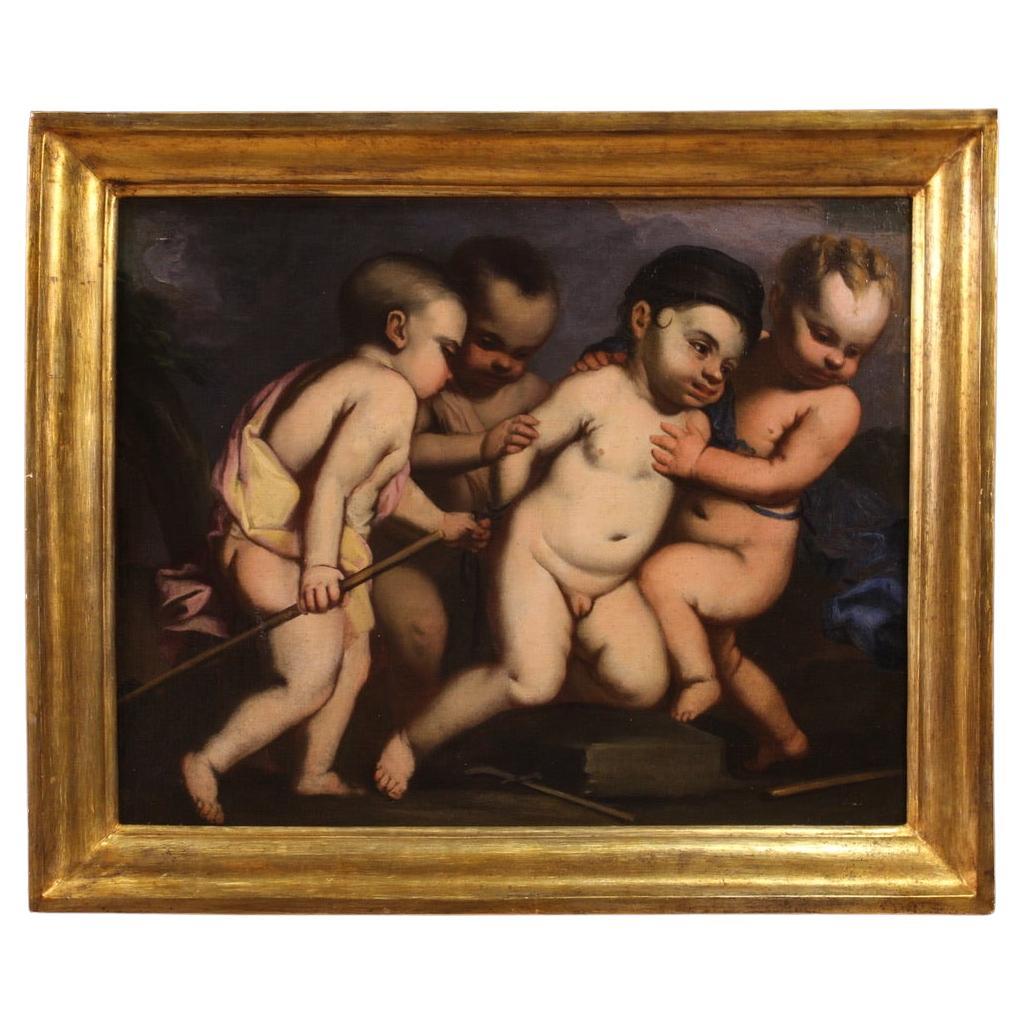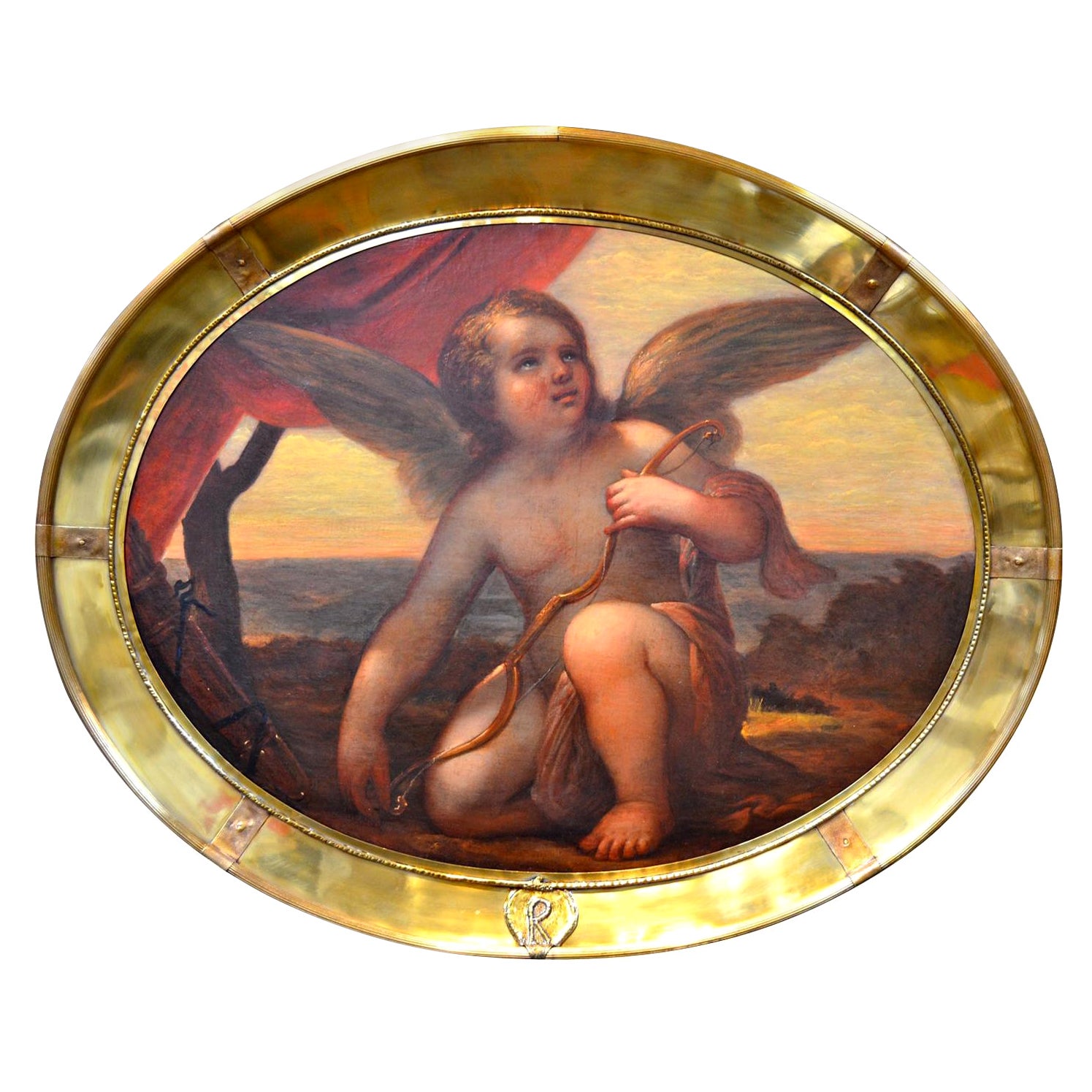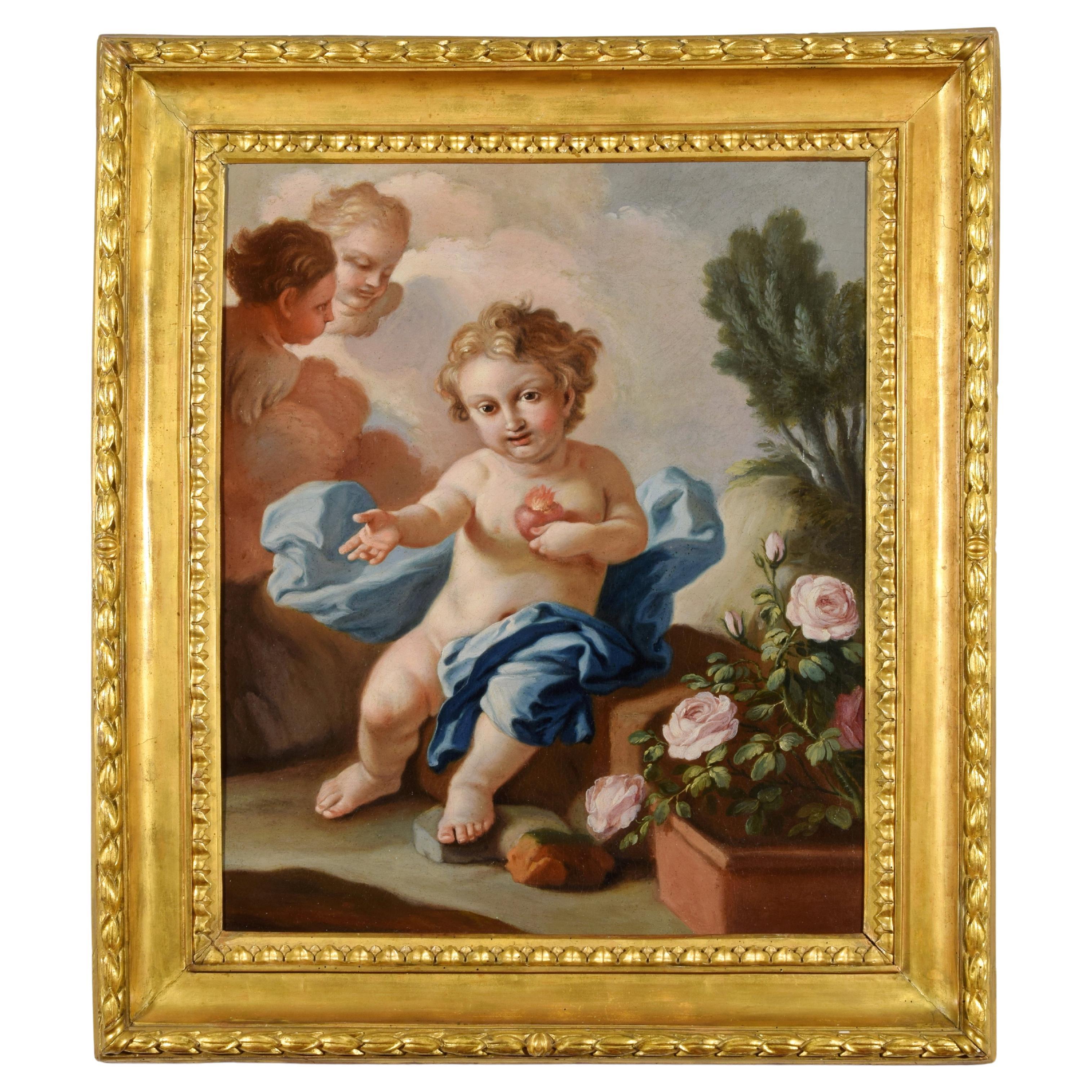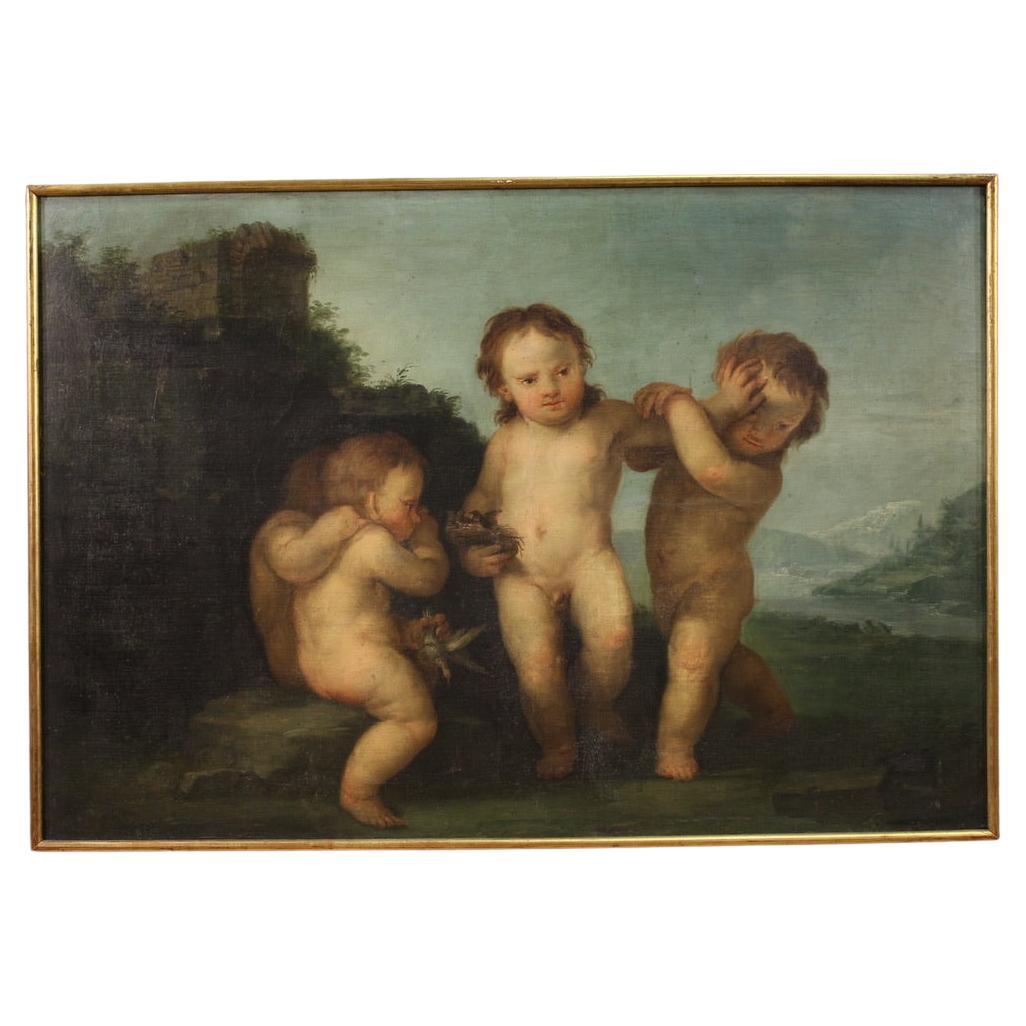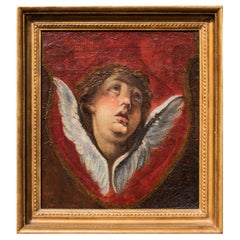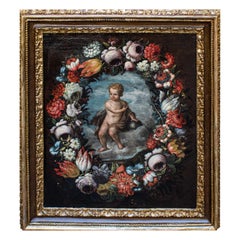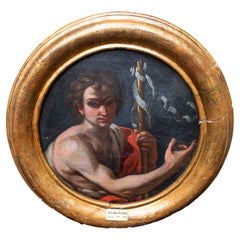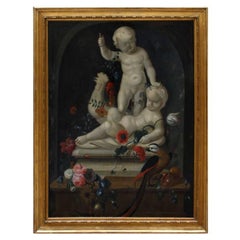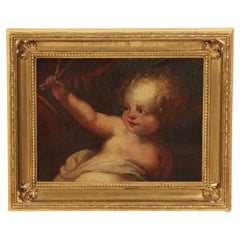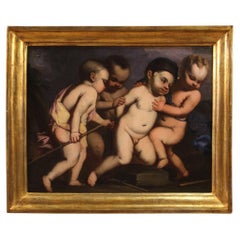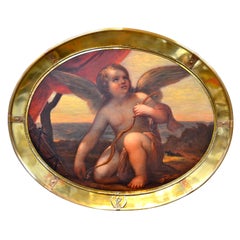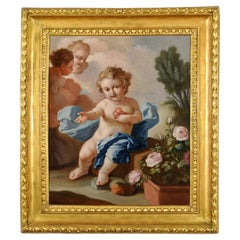Items Similar to 17th Century Putto with Rose Painting Oil on Canvas Emilian School
Want more images or videos?
Request additional images or videos from the seller
1 of 13
17th Century Putto with Rose Painting Oil on Canvas Emilian School
$2,874.58
£2,130.22
€2,400
CA$3,924.34
A$4,365.67
CHF 2,288.54
MX$53,347.42
NOK 29,141.68
SEK 27,432.86
DKK 18,273.39
Shipping
Retrieving quote...The 1stDibs Promise:
Authenticity Guarantee,
Money-Back Guarantee,
24-Hour Cancellation
About the Item
Emilian school, 17th century
Putto with rose
Oil on canvas, 43.5 x 32 cm - with frame 45 x 32.5 cm
The figure of the putto, when equipped with specific attributes, lends itself to multiple iconological meanings. The present holds a delicate flower and at the same time gaily observes the viewer, spreading soft wings. A tender light illuminates the semblant, defining the volumes of the composition. Thus an elusive allegory of love is implied, to which the puttino is a preferential representative, and the crystalline flower, which resembles both a rose and a peony, emphasizes both the temporality of the feeling and the joy it brings. Even the open wings of the little putto, in addition to slender the figure through a slight dynamism, underline the immanence of the loving feeling, all-encompassing at a single time. The uncontaminated nature of the rose also interested the Christian world in the figurative arts, identifying with it the figure of the Virgin, called "Rose without thorns". In the pagan world the flower was related in particular to the goddess Venus, but the subsequent medieval reflection on it gave rise to many symbolic nuances, linked, as mentioned above, to time, love, truth and innocence.
The particular pink base, accorded to the specific amber skin of the child, allows to recognize an Emilian executive context, underlined, in old age, by the happy parable of Felice Fortunato Biggi (1680-1750), who re-proposed a similar Putto with flowers, today in Brescia private collection, in the middle of the 18th century, to testify the territorial appreciation of the subject. Simone Cantarini (1612-1648) re-proposed through technical virtuosity the same softness of the flesh in the figure of Jesus with the painting Madonna with Child and Saint Charles, now preserved at the Pallavicini Gallery in Rome; defined by Luigi Lanzi as “a great esteem for himself, contempt for everyone else”, the artist quickly became the most capable pupil of Guido Reni, importing the Emilian manner into the Marche region.
- Dimensions:Height: 17.72 in (45 cm)Width: 12.8 in (32.5 cm)Depth: 1.58 in (4 cm)
- Materials and Techniques:
- Place of Origin:
- Period:
- Date of Manufacture:17th Century
- Condition:Refinished. Wear consistent with age and use. The painting has been cleaned.
- Seller Location:Milan, IT
- Reference Number:1stDibs: LU5918226615872
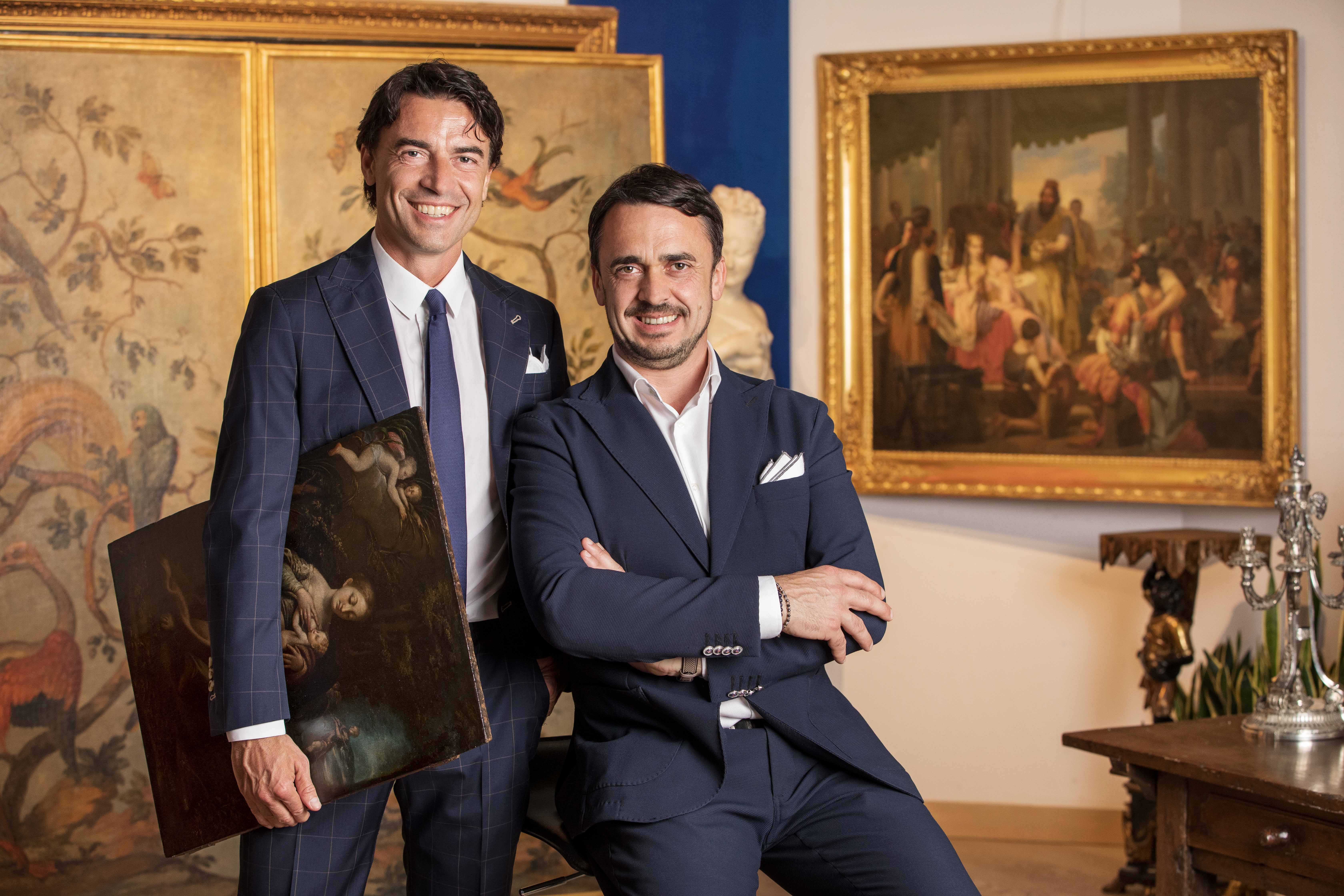
About the Seller
5.0
Vetted Professional Seller
Every seller passes strict standards for authenticity and reliability
Established in 2000
1stDibs seller since 2021
30 sales on 1stDibs
- ShippingRetrieving quote...Shipping from: Milan, Italy
- Return Policy
Authenticity Guarantee
In the unlikely event there’s an issue with an item’s authenticity, contact us within 1 year for a full refund. DetailsMoney-Back Guarantee
If your item is not as described, is damaged in transit, or does not arrive, contact us within 7 days for a full refund. Details24-Hour Cancellation
You have a 24-hour grace period in which to reconsider your purchase, with no questions asked.Vetted Professional Sellers
Our world-class sellers must adhere to strict standards for service and quality, maintaining the integrity of our listings.Price-Match Guarantee
If you find that a seller listed the same item for a lower price elsewhere, we’ll match it.Trusted Global Delivery
Our best-in-class carrier network provides specialized shipping options worldwide, including custom delivery.More From This Seller
View All18th Century Cherub Head Sketch Painting Oil on Canvas
Located in Milan, IT
Venetian school, 18th century
Study with the head of a cherub
Measures: Oil on canvas, 45.5 x 41 cm - with frame 54.5 x 49.5 cm
The present qualifies as a study or preparatory sketch by virtue of the structural and figural layout; by reason of formal and substantial evidence, it can be traced back to the mature neo-Venetian style, which in the eighteenth century had begun to produce figurations of extreme typological pathetism and formal expressionism. The contemporary painting experience of Tiepolo commanded the Venetian art scene, once the lesson of Pier Francesco Mola (1612-1666) was overruled.
The delicate putto head offered here, in which a cherub is recognizable due to the happy iconographic solution of the wings placed under the angel's face, is outlined with a vigorous vitalism. A foreshortened point of view illuminates his face in a grazing way, probing his features with strong shadows and with a youthful blush that orange his cheeks. The veristic perfection with which the artist arranges the semblant is of marvelous expressiveness. The eyes are swollen with intensity, and together with the general setting of the head they denounce a conscious reflection on the physiognomy, peculiar within the emerging context of Venetian painting.
The painting in question is affected by the large-scale productions, both monumental and perspective, at the time in vogue in the territory of the Serenissima. Conceived through a vision from below, the portrait reveals from the Venetian Rococo that particular predilection for the open and clear, airy ways, denounced in the first instance by Tiepolo. The conscious detachment from the Cortona-style decorativism and from the repeated layout solutions then in vogue allow us to approach the present to the production of Francesco Fontebasso...
Category
Antique 18th Century Italian Rococo Paintings
Materials
Canvas
Oil on canvas Jesus child within garland of flowers 18th century
Located in Milan, IT
Lombard School, 17th century
Christ child with globe within garland of flowers
Oil on canvas, 72 x 61 cm
Framed 90, 5 x 80
The present painting, framed by a sumptuous antique fr...
Category
Antique 18th Century Paintings
Materials
Canvas
17th Century St. John Baptist Florentine School Painting Oil on Canvas
Located in Milan, IT
Florentine school, 17th century
St. John Baptist
Oil on canvas, diameter cm 20 - with frame diameter 30
In this small round-format canvas, St. J...
Category
Antique 17th Century Italian Paintings
Materials
Canvas
18th Century Parrot with Cherubs and Flowers Painting Oil on Canvas by Reneman
Located in Milan, IT
I. Reneman (Netherlands, active in the second half of the 18th century)
Parrot with cherubs and flowers
Oil on canvas, 100.5 x 84.5 cm
Signed on the base “I. Reneman fecit...
Category
Antique 18th Century Dutch Paintings
Materials
Canvas
16th Century Madonna of the Carnations Painting Oil on Canvas from Raffaello
By Raphael (Raffaello Sanzio da Urbino)
Located in Milan, IT
16th century, by Raffaello Sanzio (Urbino, 1483 - Rome, 1520)
Madonna of the Carnations
Measures: Oil on canvas 38 x 30 - with frame 59 x 52.5 cm
The Madonna dei Garofani made b...
Category
Antique 16th Century Italian Paintings
Materials
Canvas
17th Century Madonna with Child Painting Oil on Canvas Tuscan School
Located in Milan, IT
17th century, Tuscan school
Madonna and Child
Oil on canvas, 31 x 21 cm
With frame, cm 37,5 x 27,5
The pearly incarnations and the thoughtful play of looks between the Virgin, turned to the Son, and Questi, warmly open to the viewer, pour out the present painting with compositional perfection. Virginal fabrics become mottled at the folds, wrapping the Madonna in a thin vitreous mantle. The pastel colors, shining on the pink robe just tightened at the waist by a gold cord, enliven the faces of the divine couple in correspondence of the cheeks, lit by an orange warmth. Even the left hand of the Virgin, composed in perfect classical pose (Botticelli, Madonna with Child, 1467, Musée du Petit Palais, Avignon), is sprinkled with warmth thanks to the immediate touch with Christ. From the nimbus of the Mother a delicate luminous disk is effused, which takes back, in the most distant rays, the colour of the hair of the Son, from the tones of the sun. The Child Jesus is represented intent in a tender gesture of invitation with the right hand, while with the other he offers a universal blessing: with his hand he retracts the index and annular palms, extending the remaining three fingers, symbol of Father, Son and Holy Spirit.
The painting welcomes and re-elaborates that typically Tuscan formalism that boasted in the rest of Italy the constant appreciation by the most up-to-date artists and collectors. Arrangement, composition and mixing of colors place the canvas in the middle between the changing mannerist and the sculptural figures of Michelangelo, essential yardstick of comparison in terms of anatomical and expressionistic rendering. In the present, silvery and pinkish powders act as three-dimensional inducers to the Child’s mentioned musculature and to the vivid folds of the clothes, expertly deposited on the lunar whiteness of the skins. While these colours recall the equally brilliantly transparent colours of Pier Francesco Foschi...
Category
Antique 17th Century Italian Paintings
Materials
Canvas
You May Also Like
18th Century Painting of Cherub/Putti
Located in Pasadena, CA
This is a charming painting of a cherub with an arm extending forward, perhaps hold out a bouquet of flowers. The painting dates to the mid-18th century and is probably cut from a larger painting. The putti is well-framed in a French a gold leafed neoclassical-style. Considering the quality of this painting, and although not signed, the painting was most probably painted by a recognized Italian 18th century artist.
Category
Antique Late 18th Century Italian Rococo Paintings
Materials
Gold Leaf
Italian Antique Painting Oil on Canvas Cherub Games from the 17th century
Located in Vicoforte, Piedmont
Antique Italian painting from the first half of the 17th century. Oil artwork on canvas depicting an allegorical subject, Game of cherubs, of excellent pictorial quality. Painting of...
Category
Antique 1650s Italian Paintings
Materials
Canvas
Venetian 17 Century Baroque Oil on Canvas Painting of Kneeling Cupid
By (after) Raphael (Raffaello Sanzio da Urbino)
Located in Vancouver, British Columbia
A fine and rare painting of a kneeling cupid holding a quiver, shown against an idyllic background. The style and subject matter are similar to works by Venetian masters from the 16t...
Category
Antique Early 17th Century Italian Baroque Paintings
Materials
Brass
$14,000 Sale Price
20% Off
18th Century, Italian painting with Sacred Heart of the Child Jesus by Pietro Ba
By Pietro Bardellino
Located in IT
Pietro Bardellino (Italy - Naples, 1732 - 1806), attr., Sacred Heart of the Child Jesus
Measurements: with frame, cm L 86 x H 99 x P 8; only the canvas, cm L 78 x H 64
The painting, made in oil on canvas, represents the Sacred Heart of the Child Jesus. Stylistically the work is attributable to Pietro Bardellino (Italy, Naples, 1732 - Naples, 1806), a pupil of Francesco De Mura and considered by critics one of the most gifted and sensitive exponents of the Rococo style in Naples.
The canvas represents the Child Jesus, surrounded by flowers in an outdoor setting, while showing the sacred heart. The canvas has a well-balanced color and a strong sweetness of the child’s traits, which with the complicit gesture of the right hand, involves the viewer in the intimate and delicate sharing of the garden in which he sits. The roses, in addition to being a beautiful piece of still life, contribute to enrich the Christological message, being bearers of symbolic meanings. Marian attributes par excellence, are often side by side with Christ, whose thorns foreshadow the Passion. In the canvas, on the top left, two cherubim are observed: among them, according to the Old Testament, is God: the author therefore puts into place an iconographic and iconological hyperbole that amplifies its meaning. The iconographic theme of the Child Jesus with the Sacred Heart in his hand spread between the second half of the eighteenth century and the first of the following century. With the worship of the Sacred Heart of Jesus, the Catholic Church intends to honour the Heart of Jesus Christ, one of the organs symbolizing his humanity, which by intimate union with the Divinity, has the right to worship and love of the Saviour for men, of which His Heart is the symbol. It represents one of the fundamental devotions of Christian life, as it manifests the true face of God, who is prodigal and boundless love. It was the French mystic Saint Margaret Mary Alacoque...
Category
Antique Mid-18th Century Italian Baroque Paintings
Materials
Canvas
18th Century Oil on Canvas Italian Cherubs Game Antique Painting, 1760s
Located in Vicoforte, Piedmont
A magnificent 18th-century Italian painting. This oil on canvas painting depicts a splendid idyllic landscape with nude cherubs at play. One of them proudly displays a nest full of b...
Category
Antique 1760s Italian Paintings
Materials
Canvas
17th Century Italian School "ECCE AGNUS DEI"
Located in Madrid, ES
17th century Italian School "ECCE AGNUS DEI"
oil on canvas
Dec. 70 x 90 cm
good condition.
Category
Antique 17th Century Italian Baroque Paintings
Materials
Paint
More Ways To Browse
Simone Cantarini
R Monti Art
Rainey Bennett
Robert Mcgregor
Roybal Painting
Russian Icon George Slaying
Serge Belloni Painting
Serge Belloni
Severin Roesen
Sir William Russell Flint
Squirrel Man Furniture
Stephanie Hoppen
Steve Burgess
Szasz Paintings
Thomas Pulgini
Turner Airbrush
Used Furniture North Shore Ma
Victor Petre
